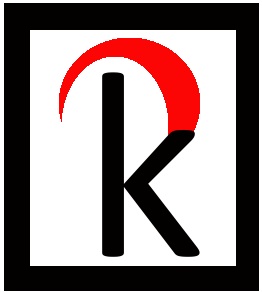5 Things You May Want to Know About… What an Art Collections Manager Does
This article is part of a new ongoing series on “5 Things You May Want to Know About…”. Future articles on this and various other subjects around collections care and collecting may be easily found by clicking on the “5 Things to Know” tag.
Managing an art collection encompasses all aspects of collections care, requiring expertise in a wide number of fields. A collections manager is responsible for record-keeping, which includes cataloguing new and existing objects but also documenting them and researching their provenance – including prior to a sale or purchase –, handling the acquisition process itself, ensuring that the right conservation environment – especially for a mixed collection– and having objects undergo conservation treatment if needed, handling long- and short-term storage arrangements, managing loans and exhibitions, keeping the movement records updated... the list goes on.
An art collections manager will therefore have many responsibilities. Among these are the following:
Help develop the client’s collection: After understanding what the collector wishes to do with their pieces (invest, keep for the long term, loan) and what their personal preferences are in terms of style, the collections manager can then assist them in developing their collections through new acquisitions. Doing so requires working with galleries, attending art fairs, staying up-to-date on art market movements, establishing relationships with different artists, etc.
Document and catalogue the pieces: Documenting and cataloguing collections go hand-in-hand. Documentation includes ensuring that all cataloguing, historical, and provenance documents can be found in the piece's file, as well as contracts, insurance, condition reports, and other related paperwork. Cataloguing is the keeping of an updated catalogue worksheet or inventory record, providing vital information on the object and for research and interpretation purposes, conservation and risk management, and even developing exhibits.
Ensure proper conservation measures: Conservation is a multifaceted part of collections care and critical to the objects' long-term preservation. Conservation comprises being aware of the environmental conditions required for display and storage (temperature, humidity, lux), how to adapt them to mixed collections, creating and updating condition reports as needed, realising when urgent conservation treatment is needed, and guaranteeing that proper handling methods are being used.
Advise on exhibits and displays: Some collectors wish to keep their pieces private, while others enjoy loaning them to museums and other institutions for various reasons, including financial ones. The collections manager may advise the collector on which pieces to display and help with all aspects of organising the exhibit, including contacting the proper specialised insurance and preparing the interpretation materials.
Assist with loans and outreach: Should a collector choose to loan a piece, the collections manager will handle some or all of the adjacent activities. These include arranging for specialized transportation and insurance, coordinating with the receiving institution on all administrative matters, staying informed on which outreach activities the piece will be shown at (educational, digital, general public), and reporting on them, and ensuring its safe return.
Effectively managing an art collection requires, therefore, professionals with vast amounts of knowledge and expertise, and access to teams who can handle the various responsibilities: curators, conservators, art advisors, registrars, shippers, provenance researchers, insurers, art analysis laboratories, among others. Collectors who hire a collections manager can be sure that their art is well taken care of, as the professional knows whom to call on and when to do so.
R.K. - Fine Art Solutions led a capacity-building seminar at the French corporate counsel association
In October 2022, I had the pleasure of co-hosting a seminar with art lawyer Cyrielle Gauvin at the French corporate counsel association ACE (Avocats conseils d’entreprise) entitled "The legal framework of the conservation profession: what about field realities?".
This capacity-building event aimed to help art lawyers understand the difference between the legal aspects involving French conservators and the reality of the profession. It also included an overview of how conservators view their work and their ethical and legal responsibilities.
I was also able to touch upon the less-discussed aspect in contemporary art of who owns the artwork and who has a final say in the work that can be done, depending on whose viewpoint it is: the collector or the artist. Whether the artist is living or has passed away but left clear instructions regarding how they wish their work to be conserved.
The ensuing exchanges with the online and in-person participants opened the door to further talks on the international aspects of conservation and a conservator's job. Amongst them was how, while there is a single universally accepted code of ethics, specificities regarding the actual work may vary according to different cultures.
Renata Kaminker – Fine Art Solutions returns as a guest lecturer to Sotheby’s Institute of Art
It was an honour to have been, once more, invited to Sotheby’s Institute of Art in London as a guest lecturer for the MA in Art Logistics.
Speaking to a room full of students on issues regarding the ethics and legalities of conservation and restoration as well as introducing them to the dynamics of restitution of cultural goods proved as enriching as always, the questions and ensuing discussions leading to new thought processes around these two important issues.
Over the course of two and half hours we covered legal and normative frameworks, case studies, the definitions of what a conservator is and the responsibilities involved in this role, the differences between restitution, repatriation, and return, and many other subjects.
As always, it was a great pleasure being involved in the MA, interacting with the students, and seeing thefuture generation of art market professionals.
Cataloguing Collections: Why, When, and How
Creating a complete record is an essential task in collections management, but for many collectors and institutions documenting each object in their possession may be arduous and sometimes seemingly costly. This is especially true when the collection is made up of several hundreds, if not thousands, of pieces.
At Renata Kaminker – Fine Art Solutions we believe that it is possible to create a full collections catalogue in a minimum of time and at a limited cost. Our job is to ensure that collections are properly cared for, and we do our best to adapt our offers to this end. We pride ourselves in making these operations simpler for our clients by either accompanying and guiding them every step of the way or taking care of the work to be done entirely.
Whether you are planning on hiring services such as ours or doing it on your own, there are a few things to keep in mind when creating a full inventory record.
Why Catalogue a Collection and When Should it Be Done
When to catalogue? As soon as the object enters the collection. If it has not been done at that time, then as soon as possible. When establishing your collection’s records the sooner it is done the better.
Why catalogue a collection? The simple answer is: because if you don’t know what you have, you won’t know what happened to it. A more complete answer requires delving into conservation and prevention issues, like theft and illicit trafficking.
Inventories allow for a detailed documentation of all objects as well as an accounting of their state of conservation at T-Time. A periodic survey, once a year, for example, allows for steady control of the works and immediate treatment if a change in state is noticed. This is essential in ensuring the long-term conservation of the pieces.
Regarding the issue of prevention, while one does not expect to either have an object stolen or find an illegally traded artefact in their hands, the fact is that theft and illicit trafficking are more common than one thinks. Those who do not have records of their objects can rarely recover them if they do disappear. An inventory file, complete with detailed photographs, is essential in recognizing and recovering works when they’re being resold after a theft.
In the case of an illicitly traded work, the inventory file serves as a record of when and how it entered the collection. And, if the documentation has been done thoroughly, will include all the paperwork regarding provenance and due diligence measures taken at the time of acquisition.
Furthermore, having a full understanding of what you have is a prerequisite when engaging in activities such as research or risk management. The former applies whether you wish to increase the value of a piece before a sale or are thinking of someday lending one for an exhibit. The latter refers back to collections preservation and protection: if you don’t know what you have and what state it is in, it will be impossible to put the proper preventive conservation, handling, and security measures in place.
Lastly, having a complete catalogue is also of great importance for insurance purposes. Comprehensive documentation can be very valuable when guaranteeing that your policy covers you properly as, over time, your collection grows in size and value. You should ideally be providing a complete record at the start of the policy, or at the latest at the time of renewal. Most insurers will usually also accept to do a policy review, if needed, when submitting or updating the records during the year.
How to Catalogue a Collection
Cataloguing can mean creating simple and quick record sheets for each piece or a more detailed file. We always advise our clients to have as much information as possible, and while this does mean more time and effort dedicated to the task when first establishing them, it also means that once the information is written down all that will be needed is a simple annual update.
Inventories, whether simple or detailed, always have the same basic categories of information. It is the level of details in these categories that make the difference.
An inventory record should have the following data:
A unique object number, using a standardised format for all the works in the collection.
The title of the piece, or if there is none then a brief one-line description.
Author, if known, otherwise Anonymous or Unknown can also be used.
If the pieces belong to a grouping or set (e.g., a jewellery or tea set), clearly indicate the number of objects in it.
A brief description, longer than the one replacing the title of the piece (2-3 lines will do).
The location of the piece, to be updated every time it is moved.
Pictures (front, back, and any important or unique details).
Technique and materials.
Date or era.
Dimensions, including the unit used.
A condition report.
Any new or updated file should also have the name of the person who worked on it and the date. This is essential in keeping track of any changes.
When delving deeper into the details, and as much as possible, records should be accompanied by:
All available documentation on the provenance of the piece.
Research references.
Handling, storage, and display requirements.
Lastly, keeping this rich documentation in a specialised database is highly recommended. While having Excel or Word files is quite common, and can serve as a temporary measure, the larger a collection is the more it needs specific technical measures put in place. The databases not only help keep track more easily of the piece’s information, such as updates to its location or the state of conservation, but most of them also feature tagging systems and broader categories that help locate similar or related objects within the collection. This is especially useful when trying to regroup objects for either a sale or a loan.
In Short
Catalogue your collection so that you know what you have, what state it is in, and how to best protect it.
Inventory records can be simple and quick, or more detailed. Both are acceptable but needless to say the more information you have the better.
Using a database is always preferable to Excel or Word files, especially for larger collections.
If you don’t know how to do any of this, are overwhelmed by the task, or don’t have the human resources to do it yourself, don’t be afraid to call on specialised services to handle it for you. These will not always be as costly as you may expect.
Summer 2021 Teaching at Sotheby's Institute of Art's MA in Art Logistics
I am delighted to have once more been invited to talk to students at Sotheby’s Institute of Art on the important legal and ethical issues surrounding conservation.
This is the second year the MA in Art Logistics is taking place, and just like last year it was a pleasure to exchange with a new generation of future art professionals.
The students and I discussed a wide range of issues, from the legal and normative framework to international conservation ethics, to ongoing debates and conservation surprises and scandals (both historical and contemporary).
I look forward to future exchanges with them, and other student groups.
Conservation Treatments and Reports as an Integral Part of Provenance Research
I’m honoured to have been invited to contribute to Flynn & Giovanni's The Provenance Research Blog.
Conservation treatments and their reports, which include condition reports, are an important yet underused asset in provenance research. As written and photographic witnesses to the state of an artwork at a specific point in time, including details on any damages, changes, place(s) of conservation, and history of the piece, these reports are an essential part of research.
You can read the full article here.
Collections in lockdown times: What do we do?
Last September I contributed to the French Blue Shield Committee guidelines for collections care under lockdown conditions. I was also in charge of translating the document into Spanish and reviewing the English version. I'm happy to announce that they've now been published!
You can download all the language versions directly from here:
The Fundamentals of Art: Questions from an Interior Designer
I’m honoured to have been invited to speak on the Decorex 2020 panel “The Fundamentals of Art: Questions from an Interior Designer”. I’ll be joining Tova Ossad (Ossad Art Management), Giovanni Sard (Lonmart Insurance), and Brian Woulfe (Designed by Woulfe).
The panel will go through the basics of what interior designers should be considering beyond just the purchase of an artwork. The discussion will cover important factors including transports, storage insurance, conservation, and general record keeping.
Join us for a live Q & A session on the 17th, 11.30 am GMT!
Register for free by clicking on the image below.
Providing better value to collectors: Technical analysis and collections management combined
The partnership between Art in Lab and Renata Kaminker – Fine Art Solutions, has allowed a collection’s owner to find the response to its scientific and collections management needs in one single place, thus saving valuable time and resources
Estelle Itié from Art in Lab and I are hard at work studying paintings under three different but complementary techniques:
Raking light
Ultraviolet (UV) photography
Infrared (IR) Reflectography
Each one of these analytical techniques provides a new level of information which will allow us to acquire a deeper understanding of the pieces under our care and the artist that produced them, while serving as added data to the inventory files being prepared.
In its most basic form, raking light renders the differences in the surface texture of the painting more visible, UV photography will provide information on which areas have been over-painted or if there is a varnish on the surface, and IR Microscopy will reveal any underlying drawings.
When combined with the previous study of the stratigraphic layers, performed a few weeks ago with co-founder of Art in Lab Ilenia Cassan, these images will allow to not only have empirical data supporting or refuting the artworks’ dating theories, but also allow for better future conservation treatment choices.
* Our client’s privacy being one of our prime concerns, when sharing any images we do so with the owner’s written permission and ensuring that the artworks are either blurred or have only details appear.
Raking light
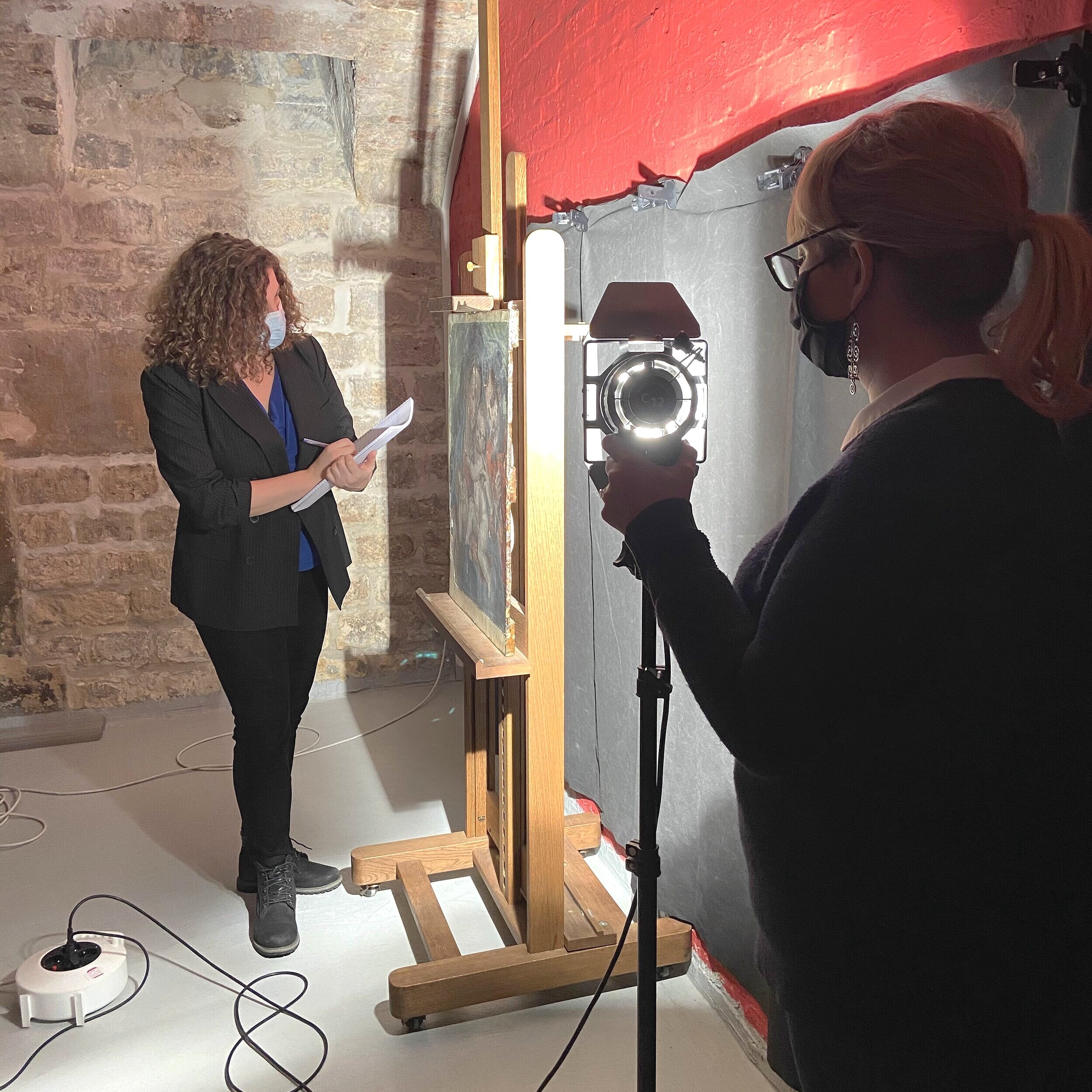
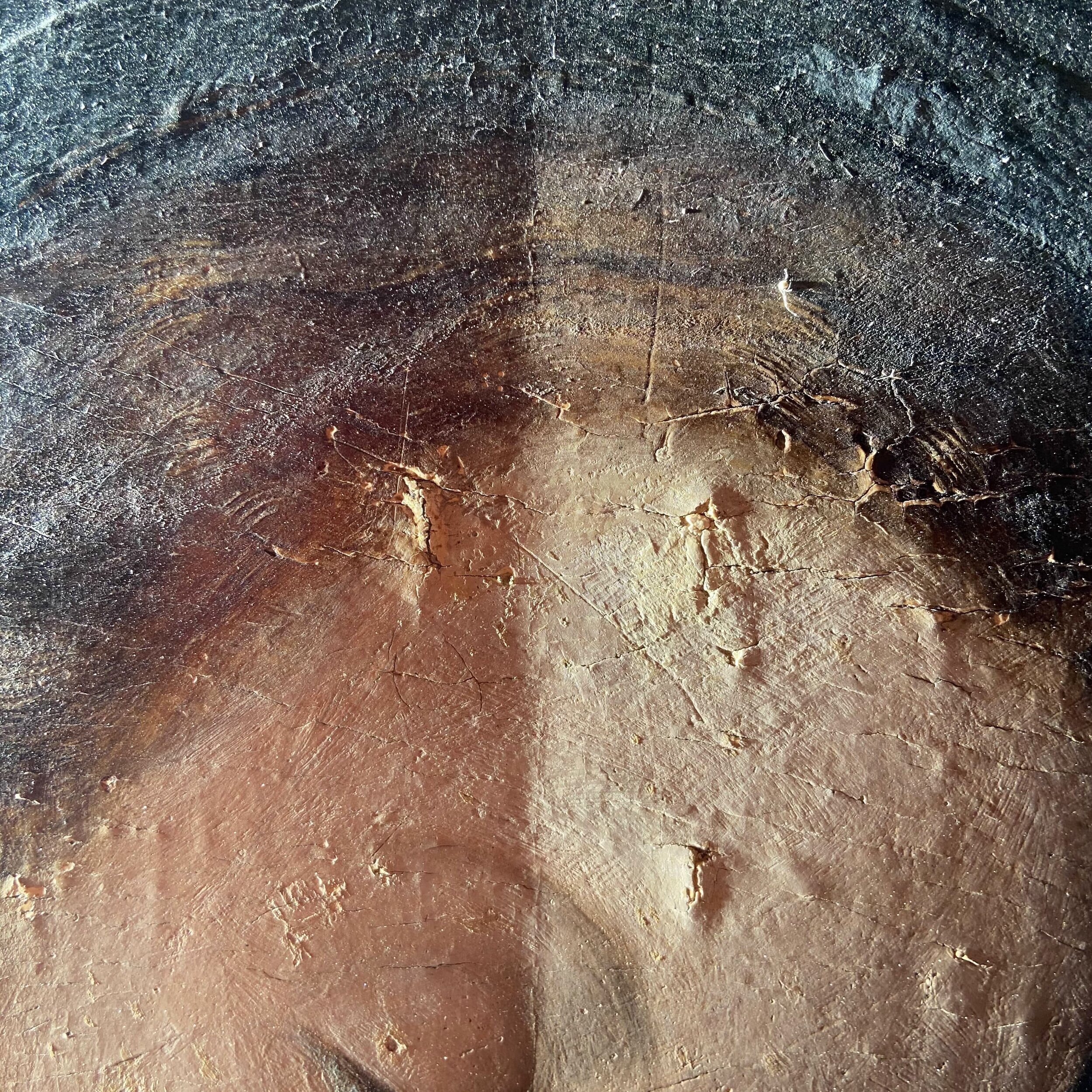

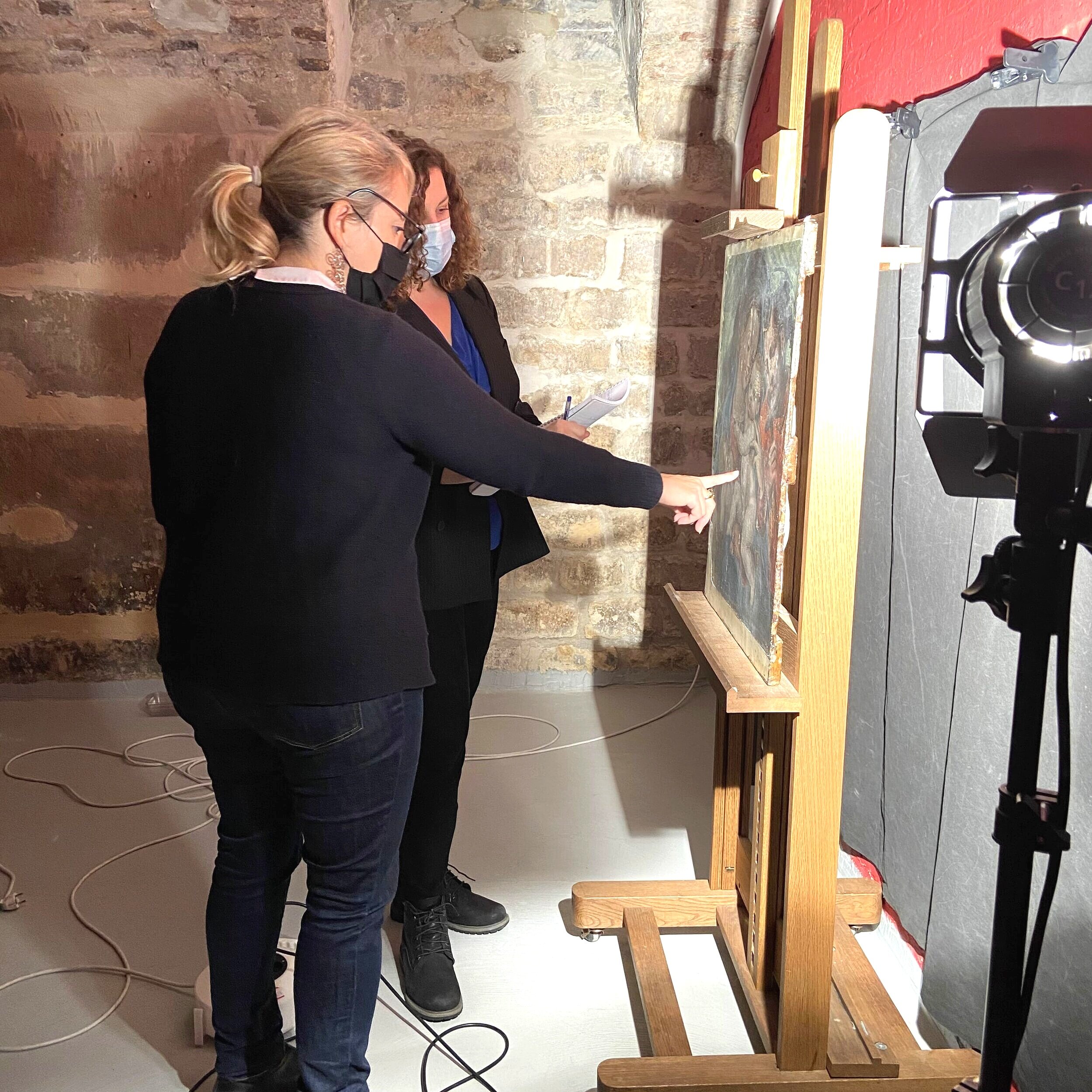
Under raking light, the painting is illuminated from only one side, at an oblique angle as related to its surface.
As stated above, raking light allows us to clearly see the surface’s texture, highlighting any differences, be it due to damage or to the artists’ doing, such as thicker brushstrokes or an impasto.
It is one of the two most common techniques used by conservators to study a piece when preparing a condition report as it reveals easily, quickly, and very clearly the surface condition of a painting.
Ultraviolet (UV) photography
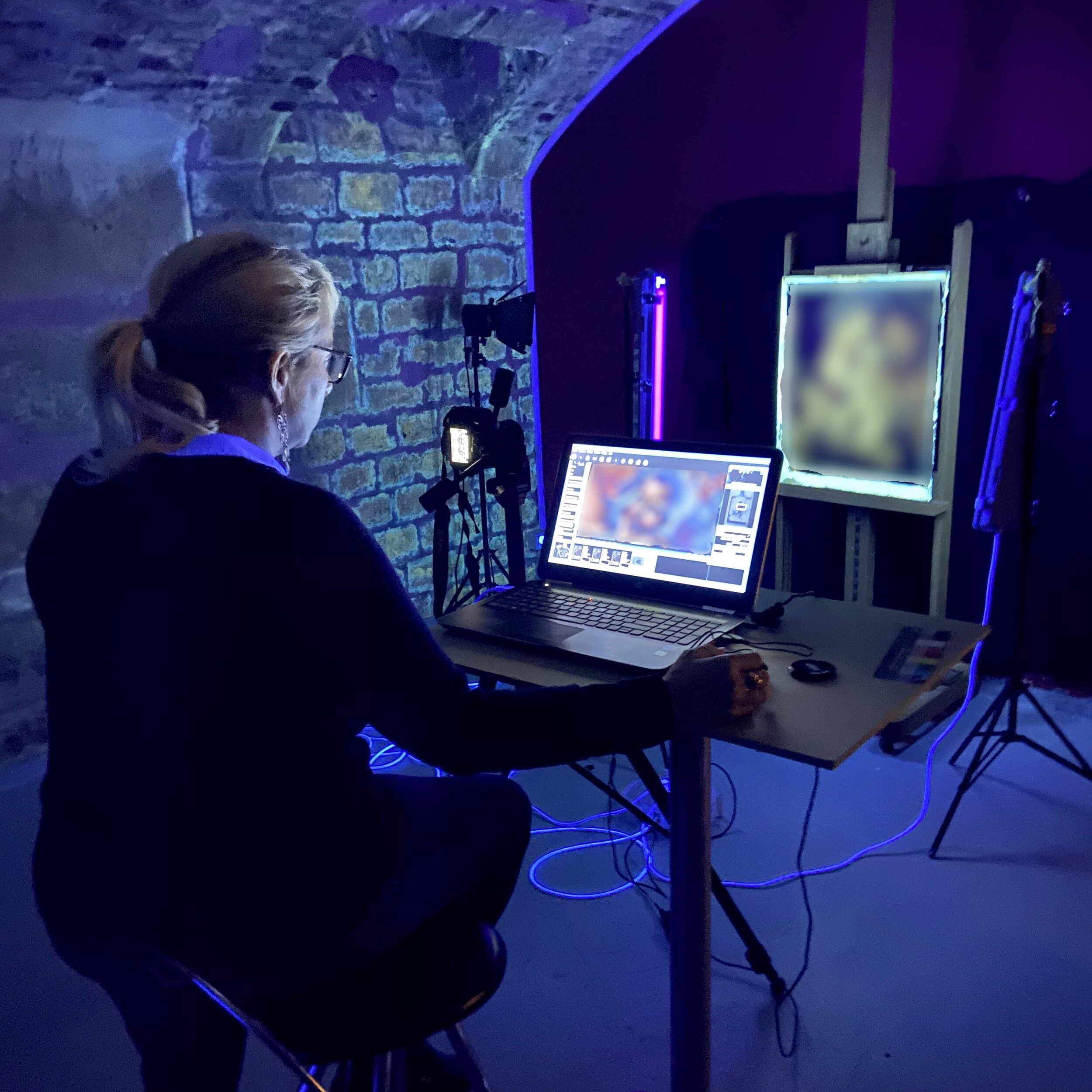
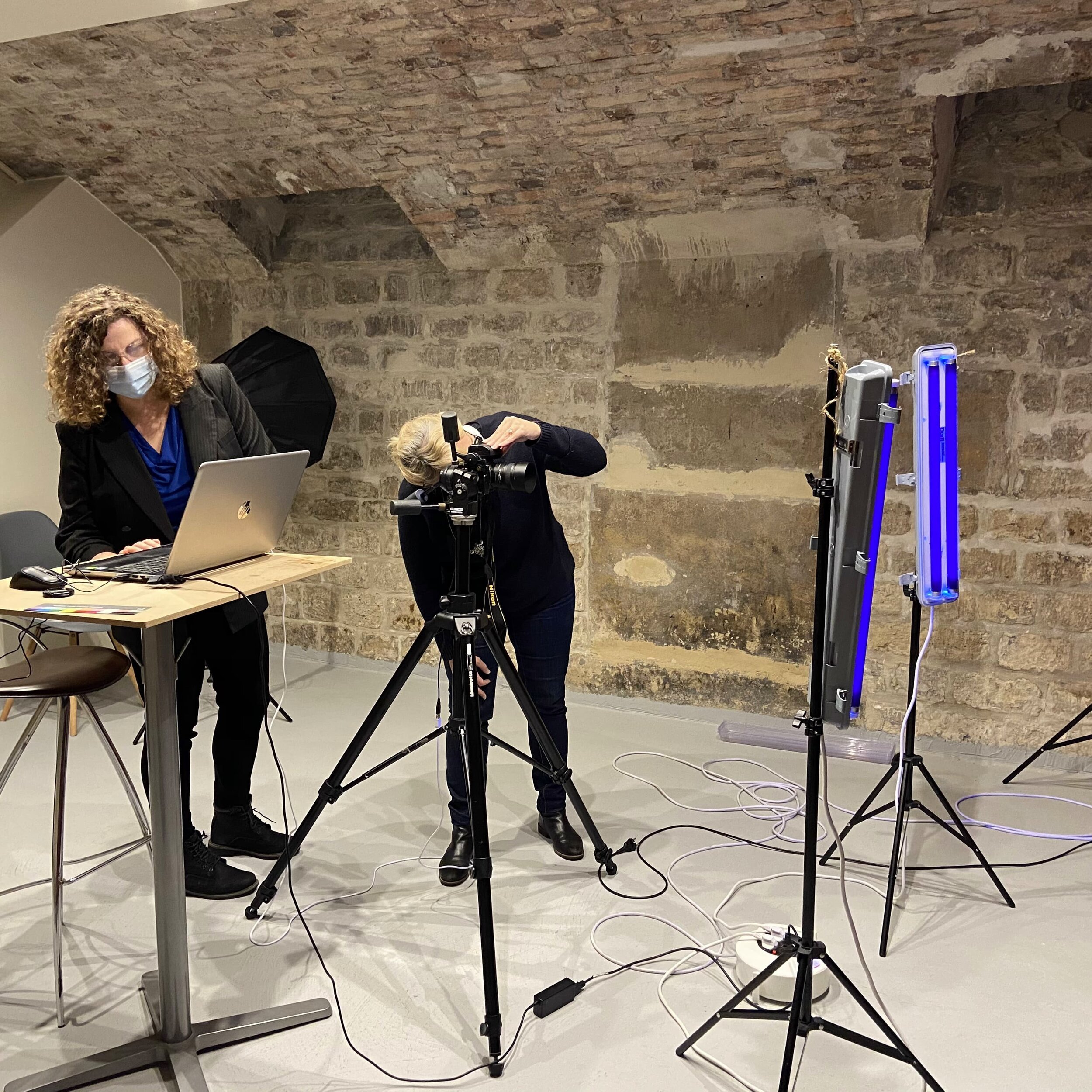
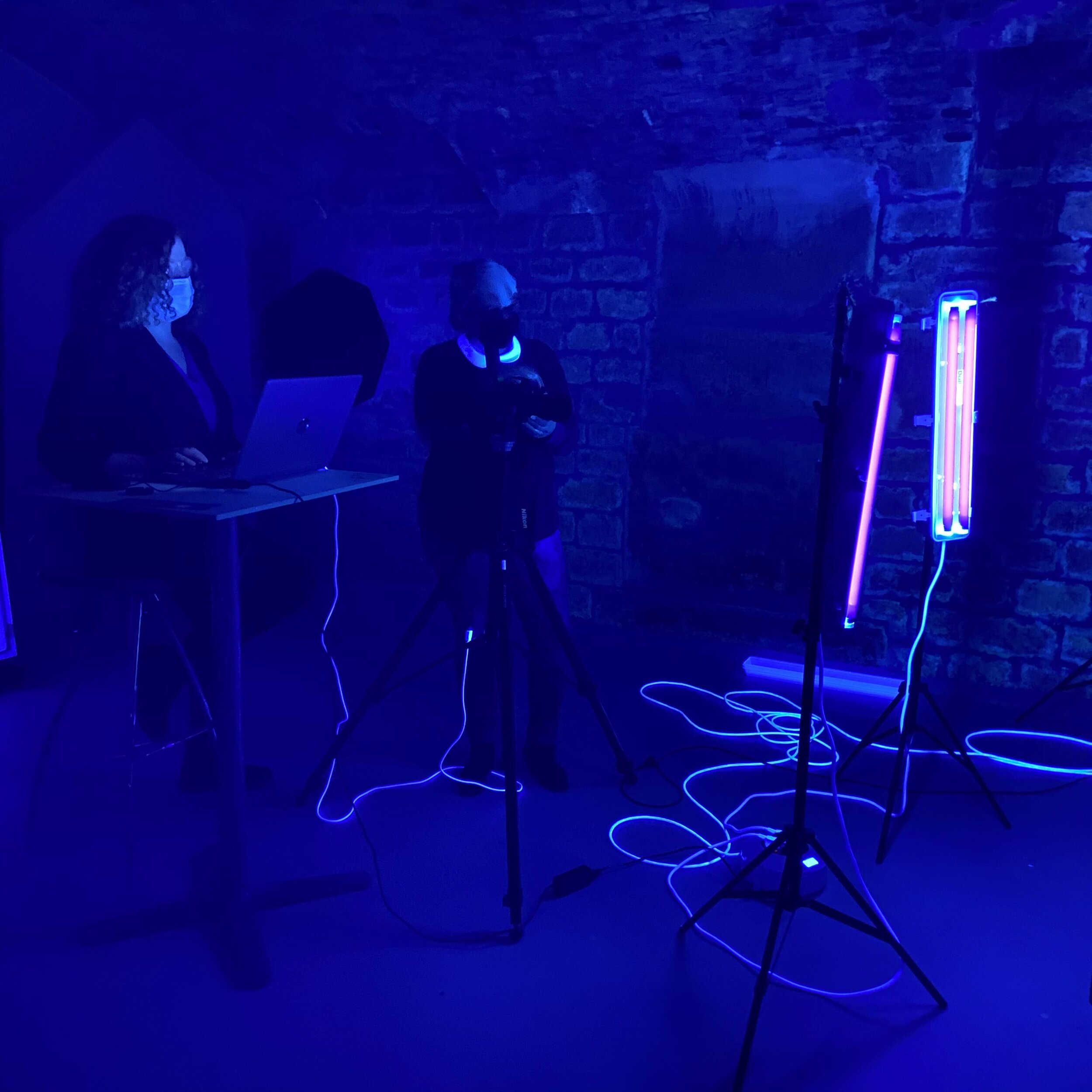
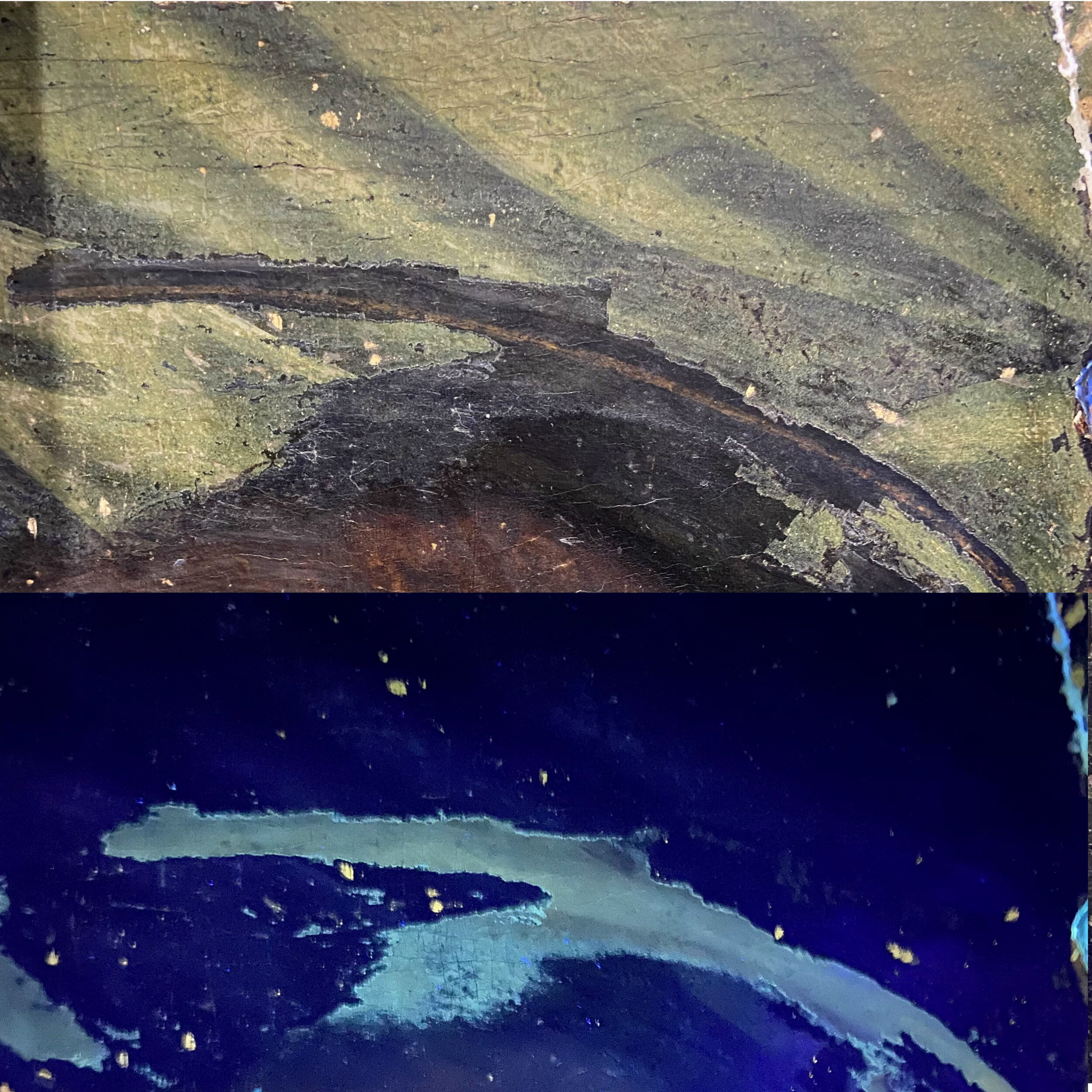
UV light is the other analytical technique most commonly used by conservators and conservation scientists alike, and is also included in condition reports.
UV light reveals:
Previous restorations, such as retouchings
Over-paintings
The presence of older natural resin varnishes
The probability of a signature or inscription’s authenticity, when compared to the surface surrounding it
The state of an artwork’s varnish
We have chosen to take things taken a step further and, in agreement with our client, have added these images to the collection’s inventory files for use in future treatment choices as well as comparison should there be any issues with the preventive conservation and storage measures that they decided on.
Infra-Red (IR) Reflectography
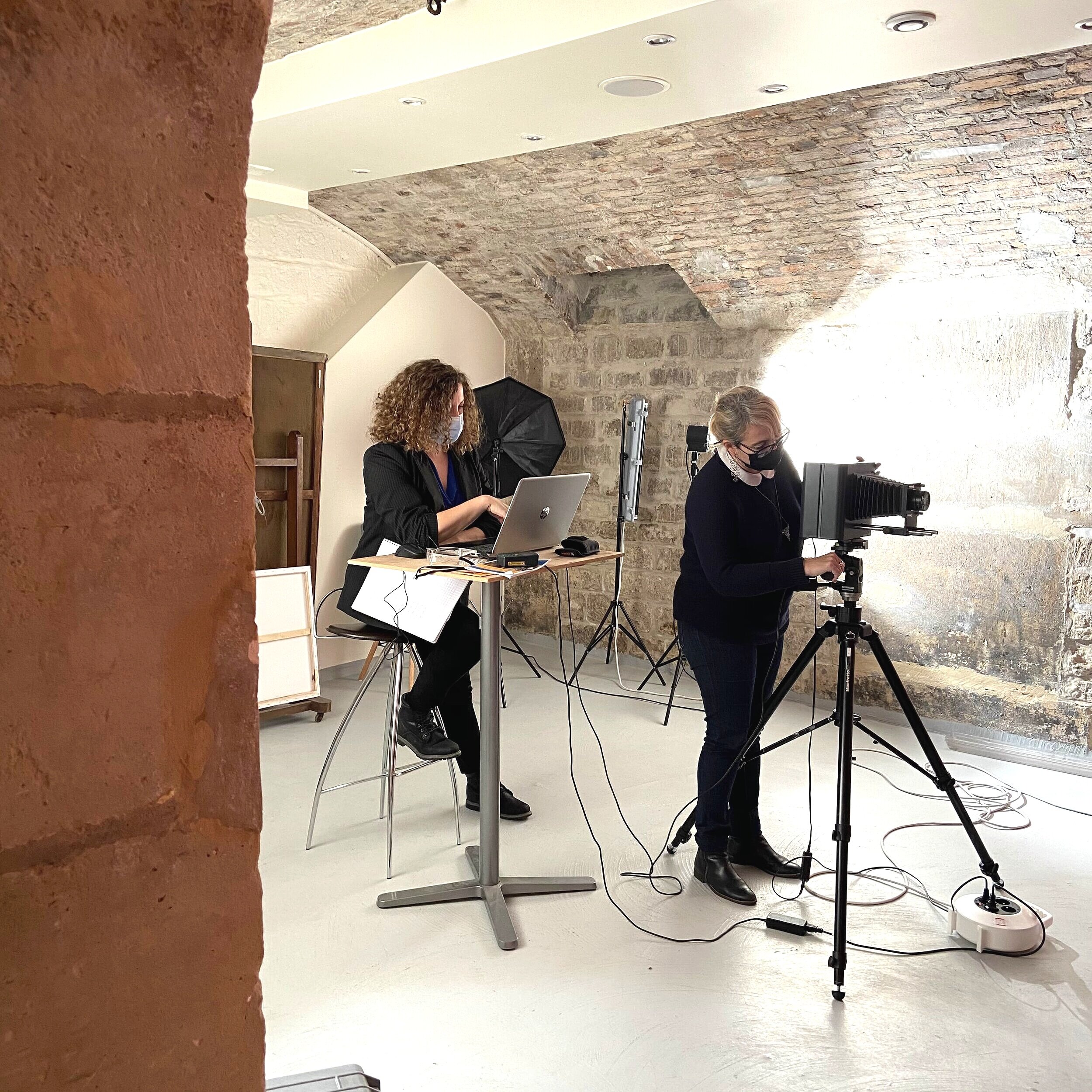
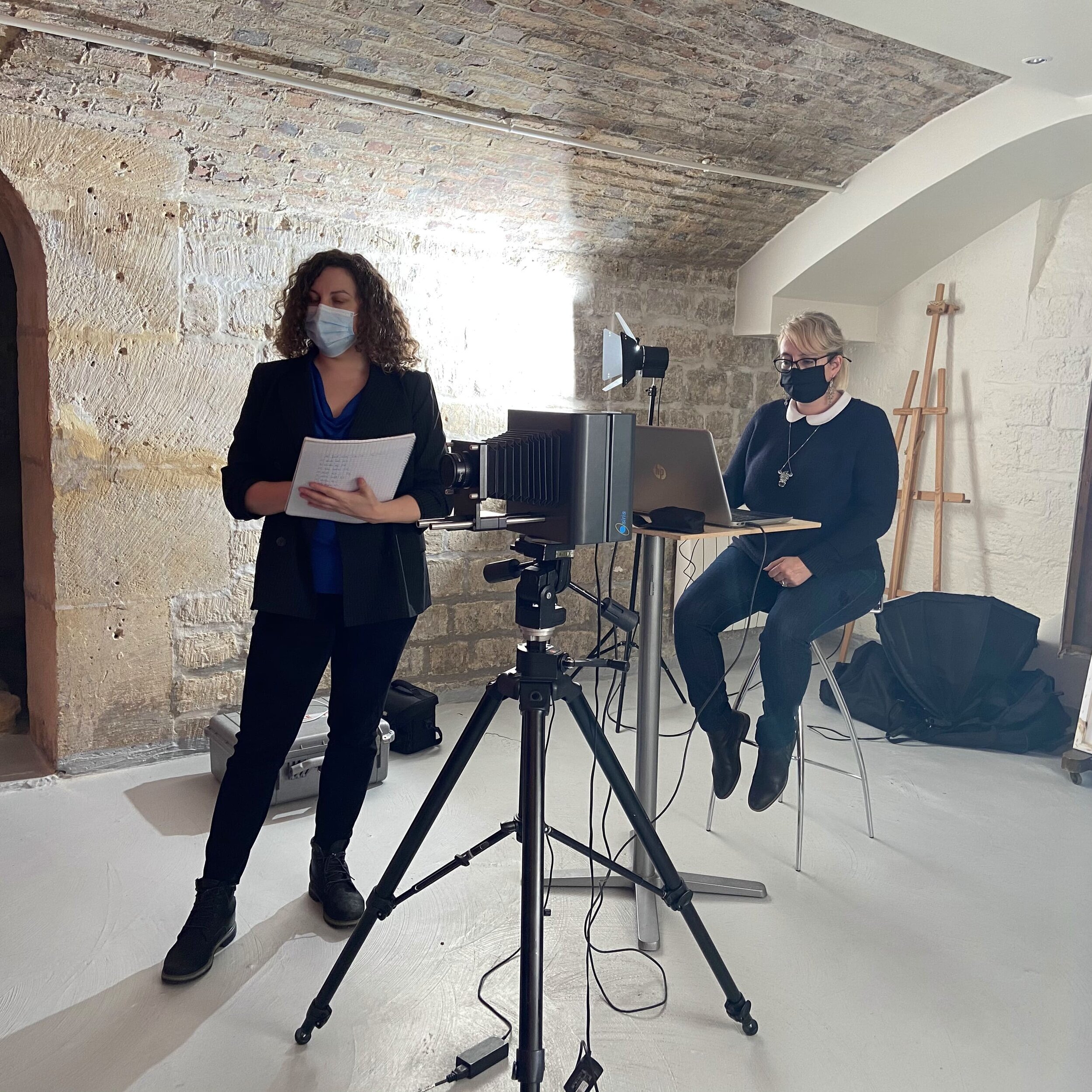
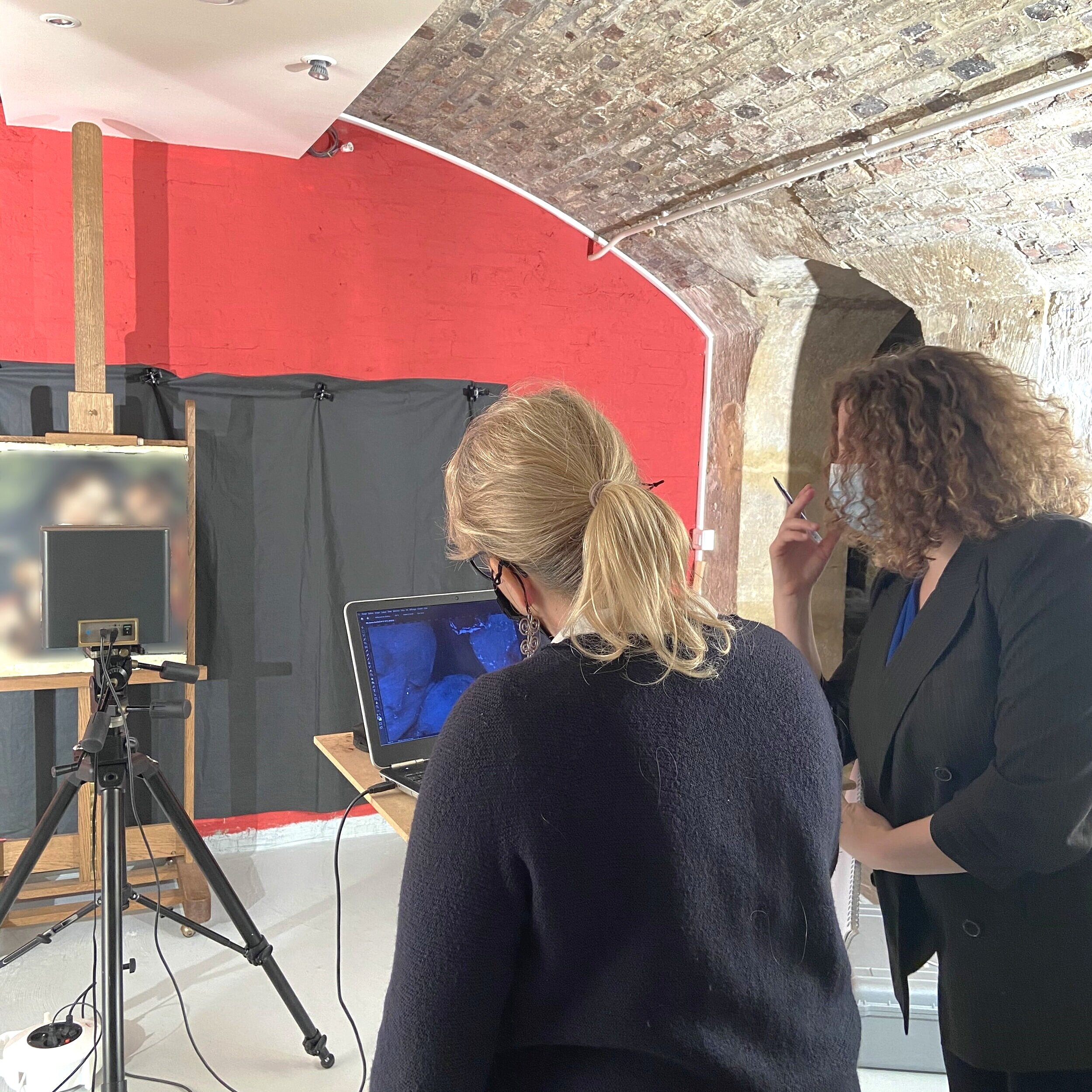
IR Reflectography is used to “see through” paint layers. This imaging technique allows us to study any existing underdrawings or compositional changes that lie beneath the visible paint layers.
IR Reflectography allows researchers to further understand the working process of an artist, which in turn will inform conservators on how to proceed. It is also used to help reveal fakes and forgeries, as these rarely have the type of underdrawings an original painting has, with all its mistakes and changes decided by the artist.
It’s been wonderful working on this collection with Art in Lab, and I look forward to future projects together. Throughout several weeks we have analysed paintings from different time periods and in different mediums, have created inventory files for all the pieces, and added condition reports to each one of these.
Thanks to the partnership between our two services the owner of these pieces has a full response to the questions of what he has, what state it is in, and what can be done to preserve it all moving forward, all in one place and without having to risk transporting the pieces or spending time going to see different specialists each in their own location.
Responding to new needs: Flood vulnerability assessments
On-going trainings in different fields are necessary to respond to the increasing diversity of questions and needs of collectors and institutions. With this in mind, last week I attended a one-day course on “Carrying Out a Vulnerability Assessment on Buildings and Equipment” (Réaliser un diagnostic de vulnérabilité sur des bâtiments et des équipements).
A mix of theory and practice, the training introduced participants to the concepts of risk and vulnerability regarding floods. We were taught how to carry out a vulnerability assessment and what reduction measures would be advisable in different situations.
As museums and collectors are very much aware of, floods will greatly damage a collection and the building, even rendering them inaccessible. To prepare for this, professionals in the cultural sector have been hard at work building disaster preparedness and emergency response plans for their institutions. Knowing what the risk points and mitigation possibilities are is imperative when putting together this plan.
The course also included how to plan for the financial drawback that a flood will cause, which is an essential part of managing a collection.
Organised by Episeine, a sub-division of the French EPTB Seine Grands Lacs, one of the aims of this event was to bring together different partners and initiatives concerned by flood risk prevention. As one of two art and heritage-related participants, it was a great pleasure to be included in this day, along with representatives of local city halls, art insurance providers and the Red Cross.
Work in progress
Thanks to the ongoing partnership with Art In Lab we are able to work on collections from a holistic point of view.
As we move forward through the different project stages, our combined knowledge and expertise allow for better understanding of the works in front of us. Which in turn will provide a more complete report to our client.
The samples are studied under microscope in order to comprehend the stratigraphic structure of the paint layers, they were taken from a 19th century French oil on canvas. As we take a deeper look at the layers that make up the piece, we can see how the creative logic used by the artist. The build-up of layers tells the story of how the artist conceived the painting should be, how he built his image up from a simple drawing to the final work. It also helps date the piece, as we acquire more information on the pigments and other materials themselves.
Sample studying also plays a key role in confirming whether any paint or varnish was added after the artist finished the artwork, all of which, when combined with other tests such as UV, IR, and X-Ray, provides key information in understanding the object’s history.
What’s cooking?
I am delighted to announce a new partnership with an old friend: Art in Lab!
Following several exchanges and meetings, Renata Kaminker – Fine Art Solutions and Art in Lab have decided to work together on a series of requests from a private client.
We are delighted to be able to offer a complete solution to an increasing problem in private art collections: What do I have? What state is it in? Is it really as old as it purports to be? Is the author truly the one I think it is?
As we plan our approach to the incoming pieces and prepare the work that this new project requires, we look forward to answering this and any other questions that may arise along the way.
Come back to read on more news and details as we advance on this new and exciting project. We will be sharing insights into the hows and whys of our intervention choices.
A unique moment in the Parisian art market field
A women-only art market club made its debut in Paris earlier this year. One of only two such bodies in the French capital, Yaam organizes monthly events where we can meet and exchange on areas of common interest.



Wednesday’s evening cocktail took place at L’espace Braque on the occasion of a pop-up exhibit for photographer André Carrara’s work, as well as other contemporary creators. A mix of art and fashion, the event was a very pleasant moment accompanied by the presentation of fascinating and beautiful work.
The cocktail event was also the occasion to reconnect with old friends and colleagues, something that the current world health situation has rendered increasingly difficult. It was a true pleasure to be able to meet again in person after so many months, and to hear how the different projects are developing.



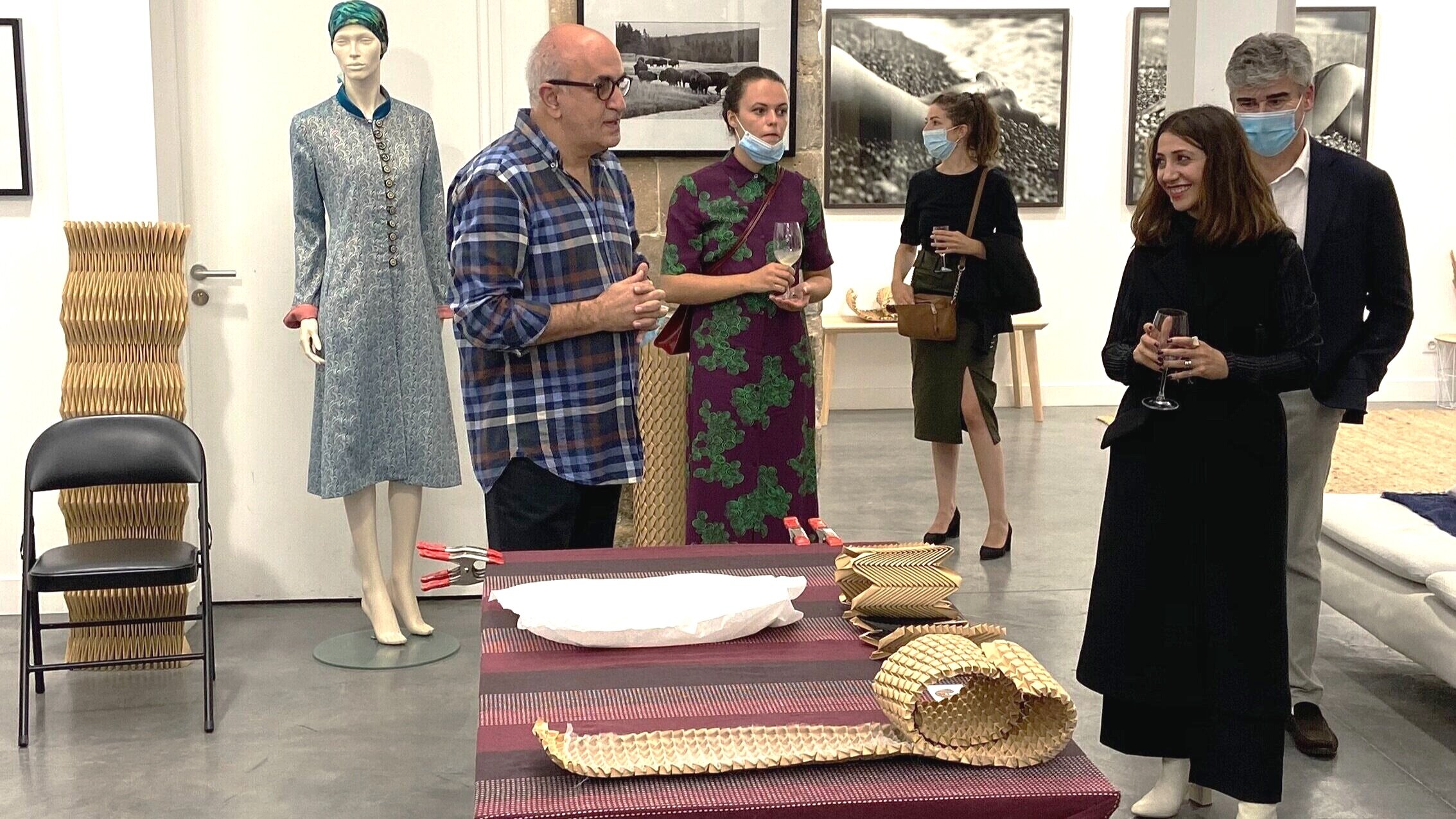



Publisher Hemeria organised the Carrara exhibit retracing a 4-decade long career as a fashion photographer and presented “Regards”, a book highlighting the tribute to Carrara’s love of what he terms women’s timeless presence and eternal beauty
The exhibition and publication retrace, in all its nuances, the evolution of the perception of femininity through some forty photographs: Mélanie Thierry, Laetitia Casta, Anna Mougladis, Nadia Vodianova, and many others ...
As an added and apt gesture to a women’s-only club, part of the profits from the sale of the shown prints will be donated to benefit La Maison des Âmes, which works to assist and house women victims of domestic violence.
Collections in lockdown: What do we do now?
Following a very busy summer working alongside the French Blue Shield Committee, I am delighted to announce that we are publishing a set of guidelines for collections care under lockdown conditions: Veille sanitaire, sûreté et sécurité en situation de confinement (Health, safety and security monitoring in lockdown situations).
The document gives a simple set of steps that may be followed when guiding your teams. It’s meant to help with monitoring situations, specifically regarding sanitary, security and safety measures.
The document is particularly aimed at institutions with limited staff and material means.
At the moment, only the French version is available, but the English and Spanish ones have been prepared and will be published in the coming weeks.
You may access and download the French document here.
Speaking (virtually) at the Art Crime Seminar, a novel experience
New times bring new and exciting challenges! On July 13, 2020, I had the pleasure of being invited back to speak at the Art Crime Seminar given by Sotheby’s Institute of Art. Though this time with a small twist: for the first time the seminar was fully on-line.
The recent Covid pandemic has forced institutions to work differently, and this has opened the doors to many new possibilities. Not the least amongst which is that students from all over the world were able to attend the seminar without having to worry about transport, food and housing.
The topic I presented this year was “Using documentation to counter the illicit trade”. It was a pleasure reaching out to young students on this subject, which touched on a vast variety of different sub-subjects, and see them engage with it and ask questions to further their understanding.
I’m, as always, grateful to Sotheby’s Institute of Art for the opportunity to teach with them, and look forward to the next occasion to do so.
Renata Kaminker - Fine Art Solutions participated in Forster's first Art Webinar and Virtual Networking event
On July 29, 2020, Forster’s Heritage Property and Art team organised their first Art Webinar and Virtual Networking event.
The webinar began with a brief introduction of Forster’s work in the art and heritage field before leading into the presentation itself. Over the next 30 minutes Gilead Cooper spoke on cultural heritage appropriation issues and provided some legal insights into well-known and highly debated cases, such as the return of the Parthenon Marbles.
The ensuing online networking rooms allowed for further exchanges on this, and other issues, in much smaller groups. Over the next 30 minutes, 3 groups of 5-6 people were settled into online meeting rooms, which allowed for more personal interactions amongst participants, much as one would do in in-person conferences.
In the midst of the Covid-19 pandemic, this original approach to networking through the use of online technologies presented an interesting experience, and one that is worth repeating in my opinion. The current situation has left professionals in the field with few options to meet, and for some there is the impossibility of travelling to those few events that do take place. Creative and thought-out online seminars like this one are highly welcome and enjoyable, and mark a decided change in the more traditional webinars where one simply sits and listens to others speak, and waits for the opportunity to ask a question through the chat bar.
I look forward to the next Art Webinar and Virtual Networking event.
"Managing Your Collection" article published in Art Law Club
I’m grateful to the Art Law Club for the invitation to write an article on collections management back in March 2020. It was a pleasure to touch on such important issues as preventive conservation and inventories.
“Managing a collection is both a simple and complex issue. There are a set number of guidelines that institutions should follow, and which cover a wide range of areas. This can seem overwhelming when one is faced with a whole collection and an entire building instead of individual pieces and rooms. It is because there is so much information to be considered that the prospect of managing a collection may seem daunting to some. In order to help institutions and their professionals get started with this task, this article aims to give a quick overview of the basic procedures…”
You may find the full article here: Managing Your Collection.
Femmes d'art: Women in the arts helping women in the arts succeed
On March 10, 2020, the newly created Femmes d’art held its first evening in Paris, France. It was a pleasure and an honour to have been able to attend this event.
Femmes d’art is the first professional networking circle in Paris dedicated exclusively to women in the art world. The evening was thus the occasion to officially launch its inauguration.






Photographs: Anas Lakrari
The event gathered professionals of all ages and professional backgrounds, from art lawyers and visual artists to provenance researchers and collections managers. It was a unique occasion for women who work in this field, in Paris, to meet and exchange on different art-world related subjects.
One of the highlights of the evening was the live podcast interview of Marianne Le Morvan, who retraced with us her journey as she researched the fascinating, and now forgotten, gallerist Berthe Weill. Active during the first half of the 20th century, Berthe Weill was the first female gallerist in history to make a career in this field without the support or backup of a male relative. She was also the first gallerist to discover and present the works of now renowned artists such as Picasso, Braque, Diego Rivera, and Modigliani.
I look forward to future events and further occasions to meet with this wonderful group and the people who form it.
Renata Kaminker - Fine Art Solutions surveyed the Musée Biochet-Bréchot’s collection
Renata Kaminker - Fine Art Solutions was recently entrusted with performing a collections survey for the Musée Biochet-Bréchot in Caudebec-en-Caux (Normandy, France). The museum, which is housed in an 12th century Templar building, is scheduled to open in early 2021.
The Musée Biochet-Bréchot holds a wide range of objects, extending from Merovingian swords to 19th century paintings. The collection presents the history of the town and the region.
The conservation survey included:
A study of the condition of each object in the collection
An overview of the preventive conservation measures in place in the exhibit space and the storage area
A review of the state of their inventory
The on-site survey will be completed by a full report presenting the findings, suggestions on how to best approach the work to be done based on legal requirements as well as priorities related to the needs of the objects themselves, and advice on the preventive conservation measures that the museum could take to better preserve their collections.
As a third-party independent report, the document will then be used by the Musée Briochet-Brechot to schedule the upcoming work in a more efficient manner, organize their upcoming budget and staff requirements, and support financial requests.
Renata Kaminker - Fine Art Solutions is delighted to be part of this exciting project and I look forward to the opening of the museum next year.
Renata Kaminker - Fine Art Solutions was once more invited by Sotheby's Institute of Art to lecture at one of its London courses
It was a pleasure to have been invited back as a lecturer at Sotheby’s Institute of Art, this time for the MA on Art Logistics, as well as an honour to have been part of the creation of the MA exam on Art Law. With over 15 years of experience in the field, it is always enjoyable to see the future generation of art professionals’ interest regarding all the legal and ethical issues faced by the market.
The lectures given were: “Legal and Ethical Issues: Conservation and Restoration” and “Art Restitution”. Students were thus introduced to the different codes of ethics that rule a conservator’s work, conservation’s legal and normative framework (at an international level, but also in France and the UK), and the importance of conservation treatments when researching collections.
We also discussed issues regarding the restitution of art and antiquities, and the class was able to use the knowledge it acquired on this issue from other art law lectures when discussing specific case studies.
I look forward to coming back to Sotheby’s Institute of Art for future exchanges and discussions, and to meet further new professionals as they prepare for a changing and ever-developing industry.
